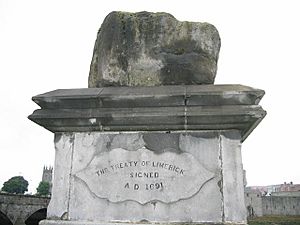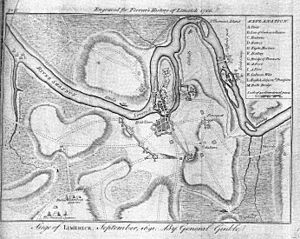Siege of Limerick (1691) facts for kids
Quick facts for kids Siege of Limerick (1691) |
|||||||
|---|---|---|---|---|---|---|---|
| Part of the Williamite War in Ireland | |||||||
 The treaty stone on which the Treaty of Limerick was signed in 1691 |
|||||||
|
|||||||
| Belligerents | |||||||
| Commanders and leaders | |||||||
| Strength | |||||||
| 20,000 | 14,000 | ||||||
| Casualties and losses | |||||||
| low, though likely some deaths from disease | c.800 killed | ||||||
The Siege of Limerick was an important battle in western Ireland. It happened during the Williamite War in Ireland, which lasted from 1689 to 1691. This was actually the second time the city of Limerick was attacked.
In 1690, the city was held by a group called the Jacobites. They managed to defend Limerick against an attack from the Williamite army. But in 1691, the Williamites tried again. After a long siege from August to October, Limerick finally gave up. However, they got good terms for their surrender.
The Second Siege of Limerick
By the time of the second siege, things were not going well for the Jacobites. Their main army had lost badly at the Battle of Aughrim in July. More than 4,000 of their soldiers were killed in that battle. Their commander, the Marquis de St Ruth, also died. Many more soldiers were captured or ran away.
The town of Galway also surrendered in July 1691. The Jacobite soldiers there were allowed to keep their weapons. They were also given a safe path to Limerick.
Even though Limerick's defenses were much stronger than before, the soldiers' spirits were low. They had lost many battles and had to retreat often. During this time, sieges were a very exact type of warfare. People even bet huge amounts of money on how long a siege would last. It is said that about £200,000 was bet on the Siege of Limerick.
The Williamite general, Lord Ginkell, surrounded Limerick. He then began to bombard the city with cannons. This created a large hole in the walls of the English part of the town.
A surprise attack by the Williamites pushed the Irish defenders away from the earthworks near Thomond Bridge. The Irish soldiers ran back towards Limerick. However, the French soldiers guarding the main city gate refused to open it for them. About 800 Irish soldiers were caught outside. Many were killed or drowned in the River Shannon.
Surrender and the Treaty
After this terrible event, Patrick Sarsfield took charge. He removed the French commanders, the Chevalier de Tessé and the Marquis d'Usson, from their positions in Limerick. Sarsfield then started talking with General Ginkel about surrendering.
They agreed on a special deal called a treaty. This treaty promised to:
- Protect the people living in Limerick.
- Allow Catholics in Ireland to practice their religion.
- Stop the Williamites from taking land owned by Catholics.
- Let Sarsfield and his Jacobite army leave Ireland with their weapons and go to France.
Limerick surrendered under these good terms in October 1691. Sarsfield left Ireland with 10,000 soldiers. About 4,000 women and children also went with them to join the French army. This journey is known as the Flight of the Wild Geese.
However, the promises made in the Treaty of Limerick were not kept. The Irish Parliament, which was mostly Protestant in 1697, did not honor the treaty. Catholics faced harsh rules called the Penal Laws. These laws treated Catholics unfairly until the early 1800s.


